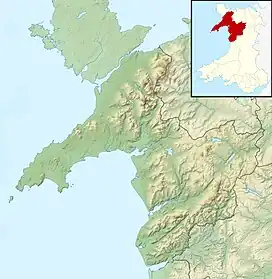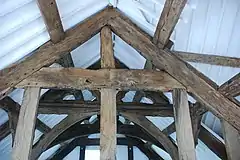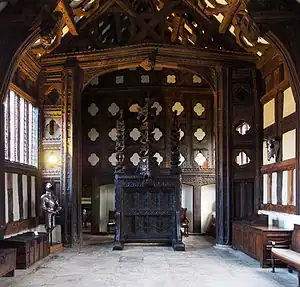| Penarth Fawr | |
|---|---|
 The west front of the hall | |
| Type | Hall house |
| Location | Llanystumdwy, Gwynedd, Wales |
| Coordinates | 52°54′48″N 4°21′08″W / 52.9132°N 4.3522°W |
| Built | c.1476 |
| Architectural style(s) | Perpendicular Gothic, vernacular |
| Governing body | Cadw |
Listed Building – Grade I | |
| Official name | Penarth-fawr |
| Designated | 19 October 1971 |
| Reference no. | 4359[1] |
| Official name | Penarth Fawr Medieval Hall |
| Reference no. | CN086[2] |
Listed Building – Grade II | |
| Official name | Former Stable at Penarth-fawr |
| Designated | 31 March 1999 |
| Reference no. | 21602[3] |
Listed Building – Grade II | |
| Official name | House at Penarth-fawr |
| Designated | 31 March 1999 |
| Reference no. | 21594[4] |
 Location of Penarth Fawr in Gwynedd | |
Penarth Fawr is a hall house in the community of Llanystumdwy, Gwynedd, Wales.[lower-alpha 1] The oldest part of the house dates from the mid-fifteenth century and consists of four bays of the original house, with the service rooms in the southern bay and the hall occupying the other three; a parlour wing to the north of the hall has been demolished. There is a seventeenth-century wing attached to the rear of the building. The original house has been altered several times, but was restored to approximately its medieval appearance in 1937 and is notable for its intact medieval roof and screen.
The hall is described as "one of the most important medieval gentry houses to survive in Wales" by Cadw, the historic environment service of the Welsh Government, and as "an important medieval hall house" in the Buildings of Wales series.[5] It is a grade I listed building and a scheduled monument, and the seventeenth-century wing and stables are each listed at grade II. Penarth Fawr passed into state care in 1949 and is now managed by Cadw.
History

Penarth Fawr was probably built built for Madog ap Howel ap Madog, with dendrochronological dating of the timbers used in the house giving a date of around 1476.[1] It was the principal house of its owners, who held a scattered estate across the Llŷn Peninsula including 39 ha (97 acres) around the house itself.[7]
The house descended in the male line to Hugh Gwyn, who was High Sheriff of Caernarvonshire from 1599 to 1600. He inserted the fireplace in the east wall, which bears his arms and the date [16]15 and likely replaced an open hearth. It is also likely that Hugh or his successor built the east wing which adjoins the south end of the hall.[4] John Wynn, the grandson of Hugh, inserted a first floor; this is commemorated in an ex situ beam in the hall which bears the inscription 'W/II 1656 FEB 20'. In 1662 Wynn was taxed for three hearths in that year's hearth tax assessment.[7]
During the nineteenth century the north end of the medieval hall and a south-east wing were demolished.[8][5] In 1886 it was bought by Owen Evans. His descendant, William Evans, undertook a significant restoration in 1937 which returned the hall to approximately its medieval state by removing the inserted floor and other accretions.[1][7] Evans placed the hall in state care in 1949, and it is now managed by Cadw.[7][9] The east wing remains a private residence. A study of the house, Penarth Fawr: a history of a medieval hall-house, was published in 2002.[8]
Description
Penarth Fawr stands on a minor road off the A497, which runs from Pwllheli to Llanarmon. The surviving fifteenth-century house is four bays long; the southern bay contained the service rooms, the second the screens passage, and the two northern bays the hall. To the west is a seventeenth-century extension. Both parts of the house are constructed of rubble stone under slate roofs.[1][4]
The west wall of the hall contains the majority of the externally-visible medieval fabric, including the door to the screens and the window to its south. The window to the north of the door was expanded in the seventeenth century but is likely medieval in origin. The south wall is contemporary with the seventeenth-century extension and contains two windows at second-floor level. The north wall is eighteenth century, and contains two blocked doorways with a window above. The east wall contains a window at the north end and a large seventeenth-century chimneybreast.[10]
The interior of the hall is divided into three; a hall in the northern two bays, the screens passage in the third, and service rooms in the southern bay. The door at the east end of the screens passage was blocked in the nineteenth century, and around the same time fireplaces were added to the south wall at ground- and first-floor level and a cellar constructed under that end of the building. The windows in southern part of the east wall were blocked when the new wing was built in the eighteenth century. The main first-floor beam on the south side of the screens passage contains evidence of full-height screen which was timber on the ground floor and wattle-and-daub above, but the arrangement of the service rooms beyond is now unclear.[7][10] In the hall itself, the north wall contains an in situ moulded tie-beam which indicates the existence of a coved roof, which would have projected further north over a dais in the demolished part of the building. The fireplace in the east wall has a large arch, and above it is a carved stone panel bearing the arms and date mentioned above.[7][10]
 The spere at Penarth Fawr, with the remains of the service rooms behind.
The spere at Penarth Fawr, with the remains of the service rooms behind. The spere and moveable screen at Rufford Old Hall, Lancashire, although more elaborate than that at Penarth Fawr, gives some idea of the original arrangement.
The spere and moveable screen at Rufford Old Hall, Lancashire, although more elaborate than that at Penarth Fawr, gives some idea of the original arrangement.
The most important feature of the house is the spere.[10] A spere is a full-height screen in a hall which separates the hall proper from its entrance passage, often, as at Penarth Fawr, taking the form of two short side walls with a wide opening between them.[11] Only about twenty examples of speres exist in Wales, mostly in the north-east, and Penarth Fawr is both the most westerly known example and the only one in Caernarfonshire.[7][5] The spere-posts at the end of the short walls are elaborately moulded and contain Perpendicular Gothic details which continue across the spere truss, the beam which runs across the top of the screen. The truss is connected to the uprights by arch braces, and above it are struts connecting to the principal rafter; the openings are all cusped, that at the apex forming a quatrefoil. The arch-braced collar beam over the central bay of the hall is similarly decorated; beyond it was originally a louvre, supported by a small cusped truss on its northern side.[7][10] The trusses in the northern wall and south of the screen are plain. In the three northern bays the two rows of purlins are supported by cusped wind-braces between the principal rafters. It is possible a moveable screen once stood between the spere-posts.[7][10]
The west wing has been largely modernised, but does contain a large timber beam in its southern wall bearing the initials 'EW' and the date 1686 which marks the location of a large chimney breast associated with the medieval kitchen. The chimney breast was removed during William Evans' restoration.[4]
Footnotes
References
- 1 2 3 4 Cadw (19 October 1971). "Penarth-fawr (Grade I) (4359)". National Historic Assets of Wales. Retrieved 14 July 2023.
- ↑ Cadw. "Pennarth Fawr (CN086)". National Historic Assets of Wales. Retrieved 14 July 2023.
- ↑ Cadw (31 March 1999). "Former Stable at Penarth-fawr (Grade II) (21602)". National Historic Assets of Wales. Retrieved 14 July 2023.
- 1 2 3 4 Cadw (31 March 1999). "House at Penarth-fawr (Grade II) (21594)". National Historic Assets of Wales. Retrieved 14 July 2023.
- 1 2 3 4 Haslam, Orbach & Voelcker 2009, p. 388.
- ↑ "Penarth Fawr Medieval House". www.visitsnowdonia.info. Visit Snowdonia. Retrieved 29 July 2020.
- 1 2 3 4 5 6 7 8 9 Avent 1989, pp. 32–37.
- 1 2 Houghton 2002, p. ?.
- ↑ "Penarth Fawr Medieval House". cadw.gov.wales. Cadw. Retrieved 29 July 2020.
- 1 2 3 4 5 6 RCAHMW 1960, pp. 112–113.
- ↑ O'Brien 2017, p. 42.
Sources
- Avent, Richard (1989). Robinson, David M. (ed.). Criccieth Castle, Pennarth Fawr Medieval Hall-House, St Cybi's Well. Great Britain: Cadw: Welsh Historic Monuments. ISBN 978-0-948-32941-8.
- Haslam, Richard; Orbach, Julian; Voelcker, Adam (2009). Gwynedd. The Buildings of Wales. New Haven, US and London: Yale University Press. ISBN 978-0-300-14169-6. OCLC 1023292902.
- Houghton, Keith E (2002). Penarth Fawr: a history of a medieval hall-house. Gwasg Eifionydd Press. OCLC 51622389.
- O'Brien, Charles (2017). Houses: An Architectural Guide. Pevsner Introductions. New Haven, US and London: Yale University Press. ISBN 978-0-300-23342-1.
- RCAHMW (1960). An Inventory of the Ancient Monuments in Caernarvonshire: II Central: the Cantref of Arfon and the Commote of Eifionydd. Vol. 2. Her Majesty's Stationery Office. OCLC 1042855041.
External links
 Media related to Penarth Fawr at Wikimedia Commons
Media related to Penarth Fawr at Wikimedia Commons- Castles of Wales entry for Penarth-fawr